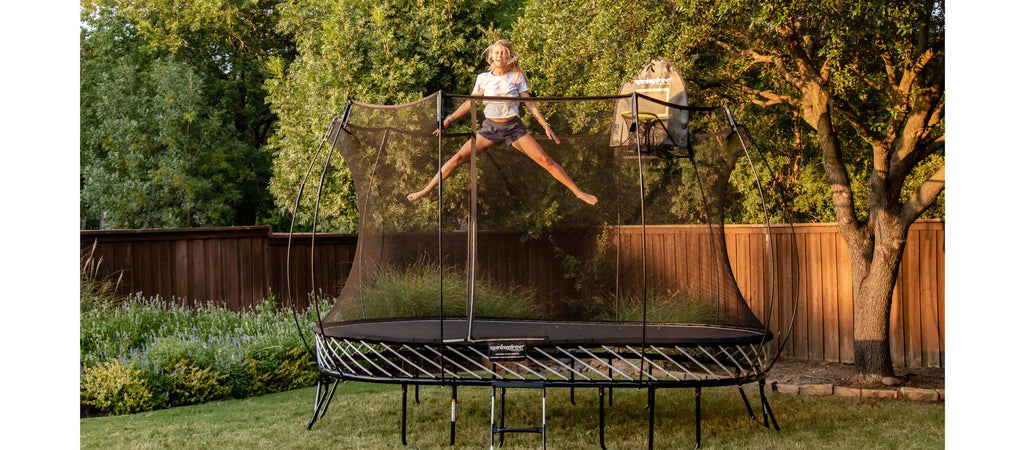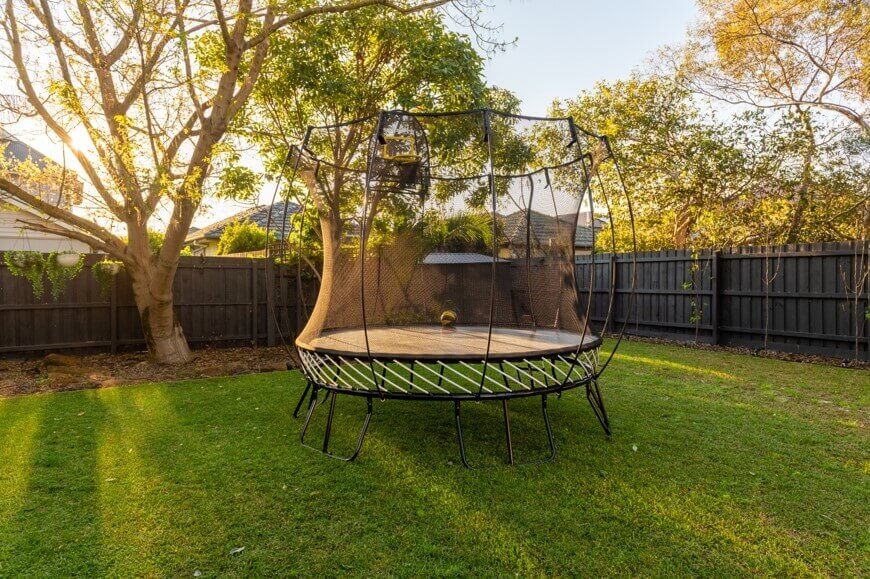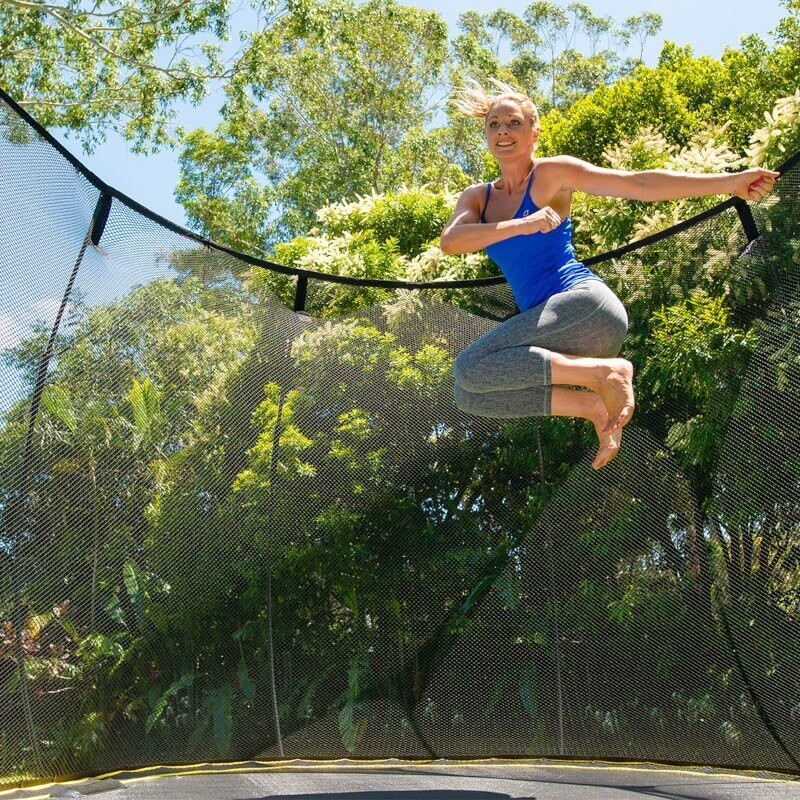Pros and Cons of Trampoline Exercise | What You Need to Know
Explore the pros and cons of trampoline exercise! Delve into the differences between rebounders and outdoor trampolines to make an informed fitness choice!
min read

Exercising on a trampoline is a common way for both kids and adults to break a sweat and get their bodies moving.
There are many pros to trampoline exercise; but like most anything, there are also a few cons that need to be considered before deciding whether to purchase a trampoline for exercise.
It’s important to consider both sides before going all in on a trampoline workout program. You don’t want to buy a trampoline for exercise and find out shortly afterward that it’s not the right fit for you.
We’re going to use our expertise as a springless trampoline innovator and manufacturer to go over the major benefits and drawbacks to trampoline exercise.
Before that, we will compare the two primary types of trampolines used for exercise: Rebounders, or mini-trampolines, and outdoor trampolines.
After reading this, you can accurately assess if exercising on a trampoline is the best way for you to get active.
Rebounders vs. Trampolines
As mentioned in the introduction, there are primarily two types of trampolines used for exercising---rebounders and outdoor trampolines. Let’s provide definitions of both:
Rebounders – Smaller trampolines, around 2-4 ft in diameter, that are used specifically for exercise.
:max_bytes(150000):strip_icc()/Web_1500-vwt-group-shots-trampoline-rebounders-jjuliao-4639-5abb6bbd642b4a05835808e35538b530.jpg)
Photo courtesy of Verywell Fit.
Outdoor Trampolines – Bigger trampolines, usually at least 6 ft wide, that sit higher above the ground and are used for both recreational jumping and exercise.

Photo courtesy of Springfree Trampoline.
There are major differences between rebounders and outdoor trampolines, including:
-
Rebounders offer less jumping space while outdoor trampolines offer more. On the other hand, rebounders take up less space and can fit inside your home.
-
Rebounders are made specifically for exercise while outdoor trampolines can be used for recreational jumping.
-
Rebounders are typically cheaper than outdoor trampolines, although there are cheap outdoor trampolines, too.
-
Rebounders are portable while outdoor trampolines usually stay in one place (although they can be moved if installed above the ground).
-
Rebounders are used mostly by adults, while outdoor trampolines are used predominantly by children.
If you’re an adult and wanting to use a trampoline for exercise only, then our recommendation would be to buy a good quality rebounder. You can also join organized classes designed around rebounders if you don’t want to buy a personal one.
The only reason you would want to purchase an outdoor trampoline instead is if you wanted more space when exercising.
However, if you have children, then an outdoor trampoline could serve a dual role of recreational jumping for the kids and an exercise platform for you.
Determining which type of trampoline to buy for exercising is critical to making a successful purchase. We’ve mapped out seven key factors to purchasing the right trampoline for your goals.
Check it out: “What to Look For When Buying a Trampoline (7 Things)”
5 Pros of Trampoline Exercise
Let’s now shift over to the benefits of trampoline exercise. These pros should be able to transfer to both rebounders and outdoor trampolines, although we will call out when one pro or con applies to one type of trampoline more than the other:
-
Improved Heart Health/Cardiovascular System
The first notable benefit of trampoline exercise is its ability to help lower your resting heart rate, strengthen your heart muscles and improve your overall cardiovascular system.
For adults, The American Heart Association recommends up to around 2.5 hours of “moderate-intensity aerobic activity or 75 minutes per week of vigorous aerobic activity.”
A trampoline can accomplish both moderate and vigorous aerobic activity depending on how you want to use it.
-
Easy on the Joints
Because of a trampoline’s soft surface, it is much easier on your joints than consistent running or jumping on a hard surface, like concrete.
According to Dr. Gabe Mirkin, the force of a trampoline is 1/6 of the force you would experience if working out on pavement. Rebounding, in particular, has shown to be a good platform to work out if you have arthritis or are recovering from an injury.
-
Trains Balance and Coordination
Training balance and coordination are critical, particularly as you age and become more susceptible to falls. Balancing or rebounding on a trampoline can stimulate the vestibule in the middle ear, which is crucial to maintaining balance.
The vestibular system “provides the sense of balance and the information about body position that allows rapid compensatory movements in response to both self-induced and externally generated forces,” according to the National Library of Medicine.

-
Helps With Losing Weight
Trampolines are also noted for their ability to help with weight loss. Trampoline jumping has actually proven to be more efficient than running on a treadmill.
According to a study by Victor L. Katch at the University of Michigan, a 150-pound person burned more calories jumping on a trampoline for 12 minutes (82 calories) than running on a treadmill (71 calories) for the same period of time.
-
Mental Health Boost
Exercising, in general, helps produce endorphins, which are signals in the brain associated with happiness.
Trampoline jumping may even contribute more greatly to feelings of positivity because it is arguably more stimulating than running on a treadmill or biking on an exercise bike.
Check out our “5 Health Benefits to Trampoline Jumping” to see the pros of trampoline exercise expanded on in greater detail!
4 Cons of Trampoline Exercise
You’ve seen some of the major advantages of exercising on a trampoline, but there are also a few drawbacks that should be considered before choosing a trampoline for workouts. Here are four cons to keep in mind:
-
Sprains and Fractures Can Occur
Jumping repeatedly on a trampoline can lead to a sprained ankle or a fracture if you land awkwardly. According to Policygenius, fractures account for almost 35% of trampoline injuries.
Lower extremity injuries, in general, are the most common type of trampoline injury. They make up 36% of trampoline injuries, via Policygenius.
-
Can Worsen Spine Conditions
If you have a relatively healthy back, then jumping on a trampoline shouldn’t produce many spinal side effects.
But those that have spine conditions like Degenerative Disc Disease, Osteoporosis, Sciatica or a pinched nerve should probably stay away from consistent trampoline jumping.
Particularly when rebounding, your spinal tissues stretch and compress concurrently, which can put additional pressure on your discs.
-
Strength Development Can Stagnate
While jumping on a trampoline works multiple muscle groups in the body, particularly in the lower body, there’s only so much resistance you can get from trampoline jumping.
Since resistance is low or non-existent on trampolines, muscular hypotrophy—an increase in muscle mass---is difficult to achieve. Adding resistance training with weights would be recommended if you’re looking to increase muscle mass while also improving cardio on a trampoline.
-
Costs Money and Takes Up Space
The last con isn’t a physical con, but it’s a worthy one, nonetheless. Trampolines require spending money and if you’re buying an outdoor trampoline, especially, you will need to accommodate the trampoline’s size.
While a trampoline could be well worth it for you, it’s important to make sure you get your money’s worth, as it is a financial investment that could take up considerable room if you buy a big trampoline.

Should You Buy a Trampoline for Exercise?
After reading through the pros and cons of trampoline exercise, would it be worth it for you to invest in a trampoline for the betterment of your health?
That decision is ultimately up to you, but if you’re looking for our expert summary on trampoline exercise, here is our perspective:
-
Trampolines are a fun way to better both your physical and mental health—including your heart health, cardiovascular system, balance, weight loss and stress levels.
-
However, trampolines can cause injuries if you land awkwardly and could aggravate previous spinal conditions. It’s also not the best platform to use for strength training or building muscle mass.
All things considered, trampoline jumping is an enjoyable way to get active and work up a good sweat. It won’t be for everybody, though.
Consider the pros and cons listed in this article and use them to help come to an educated decision.
(Check out our “10 Exercises to Tone and Tighten” to see some of the best movements you can perform on a trampoline!)
What Are the Best Trampolines for Adults?
If you do decide that a trampoline is worth looking into to achieve your fitness goals, you need to know which one to buy first.
At Springfree Trampoline, we give you the honest and objective information you need, based on our insider expertise, to make an informed trampoline purchase.
Using our industry knowledge, we’ve rounded up the six best trampolines you can buy this year if you’re an adult (they can also be used by kids!).
In the article below, there are three rebounders and three outdoor trampolines. We picked one low-budget, one mid-budget and one high-budget trampoline for both categories so that there is something for everyone—no matter what your budget for a trampoline looks like.
Check it out and get the right trampoline the first time around: “6 Best Trampolines for Adults (From Mini-Trampolines to Large!).”


